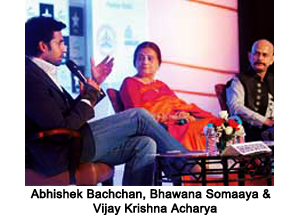Ficci Frames: Digital and television screens can co-exist
By BS Reporter, Business Standard, Mumbai - March 14, 2014
Discussions at the second day of Ficci Frames centered around how monetising can be drawn from multiple screens and how each can compliment the other rather than compete.
 In an era of multiple screens vying for the attention of viewers, experts feel television would continue to be the central screen, at least in the medium term.
In an era of multiple screens vying for the attention of viewers, experts feel television would continue to be the central screen, at least in the medium term.
While one might look at mobile screens and laptops as competition for the television news, trends show advertising on TV is not suffering at the hands of digital media. Discussions at the second day of Ficci Frames centered around how monetising can be drawn from multiple screens and how each can compliment the other rather than compete.
While all the industry stalwarts agreed that growth of digital media (social media websites and mobile internet) was much higher than that of traditional news media such as television and print, they believed the major shift in advertising revenues is sometime away.
Bhaskar Das, chief executive officer, Zee Media, said, "Advertising money
has not yet moved away from television and print to digital media. However,
over the next three-five years, this big shift will happen".
While regional print media has done very well in the year gone by, experts
believe non-English content would drive growth of digital media in India. With
deeper penetration of mobile internet into Tier-II territories, localisation in
terms of language has become very important.
Chetan Krishnaswamy, head, public policy and government relations, Google
India, said, "With four million users coming online every month, almost
all of them on mobiles, the mobile is now the real tool of empowerment. Future
users would largely be from the non-English speaking populace. Already,
language websites are growing faster than English websites. The Internet has
great power and it can only make democracy a better social catalyst."
The good news is that the three mediums namely print, television and digital
media need not necessarily compete with each other. They can in fact work
together exploring opportunities for sharing content across all the mediums.
For instance, a television news channel can carry important social media web pages
to highlight a news trend and vice-versa.
The digital medium can also act as a director towards the other screens. We see
this happening in the form of ticketing apps for cinema on the mobile and
interactive apps and advertising on mobile for television and print.
However, some did take a more conservative view on the existence of multiple
screens and felt that one could be a threat to the other.
Ashok Venkataramani, CEO, MCCS India, believes that in addition to the growing
popularity of digital media, television news channels also have to deal with
another key challenge.

